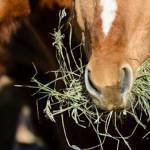How Does Hay Type Affect Glycemic Response in Horses with PSSM?

The objectives were to determine if there is a difference in the glycemic/insulinemic response to hay with high or low nonstructural carbohydrate (NSC) content in horses of Quarter Horse or related breeding, and to determine if there is a difference in the postprandial response to hay with high or low NSC in control horses compared to PSSM horses, all of Quarter Horse-related breeds.
A crossover design was used with horses randomly assigned to high-NSC (HC) or low-NSC (LC) hay for 5 days, then fed a medium-NSC (MC) hay during the 7-day washout, after which diets were reversed. Horses were fed 1.5% body weight (BW) hay daily. On the fifth day of the diet (seventh day of washout), horses were fed 0.5% BW in hay, and intake rate was recorded. Blood was drawn pre-feeding and every 30 minutes for 5 hours for glucose and insulin.
HC hay had the fastest intake rate. When fed HC vs. LC hay, control horses had a similar glycemic but higher insulinemic response. On HC hay, PSSM horses had a higher glycemic and lower insulinemic response than controls.
Results from this study suggest that glucose alone might not accurately reflect insulin responses to these feeds and that a glycemic index might not capture the complete relationship between NSC contents and metabolic impact of feeds. Postprandial insulin response, rather than glucose response, might better assess metabolic impact of hay. Hay with more than 17% NSC may not be appropriate for horses diagnosed with PSSM.
This report of KER’s 2009 research was published in Journal of Equine Veterinary Science.
Read the entire research article, titled Glycemic and Insulemic Response to Feeding Hay with Different Water Soluble Carbohydrate Content in Healthy and Polysaccharide Storage Myopathy-Affected Horses.








